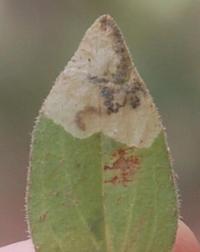Taxonomy
Superfamily:
Family: Subfamily: P3 Number: MONA Number:
Comments: The genus Mompha consists of around 46 described species in North America. In addition, numerous species remain to be described that are centered in the southwestern US (Bruzzese et al., 2019). The adults are small moths that have two or more tufts of raised scales on each forewing. The larvae either mine leaves, or bore into the stems, flower buds, flowers, or fruits of their hosts. The majority of species feed on members of the Onagraceae, but others feed on species in the Cistaceae, Lythraceae, Melastomataceae, and Rubiaceae.
Species Status: Mompha annulata is a member of a group of several small "black and white" Mompha species that occur in North America, many of which remain undescribed (Microleps.com). This species was previously known only from Illinois, Indiana, and Ohio before Tracy Feldman discovered a specimen in Wake Co., North Carolina in 2018 that was mining the leaves of Summer Bluet (Houstonia purpurea ).
Identification
Adult Markings: Braun (1923) described Mompha annulata based on two specimens that she collected in Ohio. The following is based on her description. The labial palp is silvery white inwardly and fuscous outwardly, with two black rings around the third segment. The antenna is fuscous above in the basal half and black in the outer half, with the tip white. Before the tip, there are five white segments that are separated each from the next by two black segments. The face is silvery, but shades darker on the head, which varies from gray metallic to almost black. The thorax and forewing are black. An oblique silvery bar at the basal fourth reaches the fold. Just beyond and a little below the fold there is a patch of black raised scales. At the apical third there is a slightly inwardly oblique silvery fascia, with the scales near the dorsal margin forming a raised patch. A line of silvery scales is present from just before the tip of wing around the apex to the tornus. There are two parallel rows of black-tipped scales in the cilia, and the hindwing and cilia are gray. The legs are black, with the tips of the segments and a median band on the tibia silvery. The abdomen is fuscous above, with the posterior margins of the segments silvery. Terry Harrison (BugGuide) noted that M. annulata is similar to M. argentimaculella but differs in lacking a yellow patch on the costa of the forewing just basal to the apical scale tuft (a yellow patch is present on M. argentimaculella ). In addition, the antennal flagellum is prominently ringed with white in M. annulata versus being largely dark or entirely black in M. argentimaculella .
Wingspan: 7 mm (Braun, 1923).
Adult ID Requirements: Identifiable from good quality photos of unworn specimens.
Immatures and Development: The host plants were unknown until Tracy Feldman recently discovered larvae mining Summer Bluet and Oneflower Bedstraw in North Carolina. When mining bluets the larva produces a somewhat convoluted leaf mine that contains a diffuse frass trail. A larva may make two or more mines on separate leaves before it finally pupates. When using Oneflower Bedstraw -- which has much narrower leaves -- the larva eventually mines most of the leaf to produce a blotch.
Larvae ID Requirements: Identifiable from good quality photos, especially where associated with known host plants.

 »
»


 »
»
